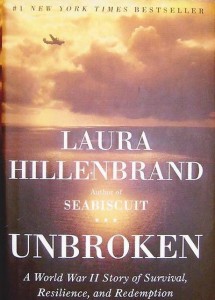 Review by Larry S. Sterett | Contributing Editor
Review by Larry S. Sterett | Contributing Editor
UNBROKEN, by Laura Hillenbrand. ©2010. Published by Random House, Dept. TGM, New York, NY. Price: $27. Available at most bookstore now in paperback.
This 498-page hardbound volume deserves to be read by everyone. Written by the author of Seabiscuit, it is a World War II story of Louis Zamperini, a 1936 Olympics distance runner for the US. Zamperini was the youngest American distance runner to make the Olympic team, and by far the fastest 5,000 meter runner of any American in 1936. He finished just out of seventh place, but had the fastest final lap (56.0 seconds), beating the 1932 Olympic 5,000 champion’s (Lauri Lehtinen of Finland) final lap time by 13.2 seconds. Louis Zamperini was definitely looking forward to winning the gold at the 1940 Olympic Games in Tokyo, Japan. It wasn’t going to happen.
 Louis Zamperini died in 2014, but it seems a miracle he managed to survive at all, after being subjected to brutal treatment by the Japanese POW guard Mutsuhiro “the Bird” Watanabe. (Watanabe died in April 2003, some 11 years prior to the death of the man he had so cruelly treated during World War II.) Divided into five parts this tome features a map of the Pacific Ocean, a preface, a lengthy epilogue, acknowledgments, an index, and fifty pages of endnotes by chapter. (The author conducted 75 interviews with Zamperini, in addition to having access to all letters to or from him and his family members.)
Louis Zamperini died in 2014, but it seems a miracle he managed to survive at all, after being subjected to brutal treatment by the Japanese POW guard Mutsuhiro “the Bird” Watanabe. (Watanabe died in April 2003, some 11 years prior to the death of the man he had so cruelly treated during World War II.) Divided into five parts this tome features a map of the Pacific Ocean, a preface, a lengthy epilogue, acknowledgments, an index, and fifty pages of endnotes by chapter. (The author conducted 75 interviews with Zamperini, in addition to having access to all letters to or from him and his family members.)
The first part is devoted to Zamperini’s pre-World War II life, while parts II and III cover the period of the War up to and the beginning of his capture and imprisonment. Trained as a bombardier, he had hoped to be on a B-17, but was assigned to a Consolidated B-24 Liberator, sometimes called the “Flying Brick,” “the Constipated Lumberer,” and even “the Flying Coffin.” Regardless of nicknames, Zamperini’s plane Super Man returned from one mission with 594 bullet holes, by actual count, in it; they lost one crewman, but many in the crew were seriously wounded.
Assigned to a so-called air-worthy replacement, the Green Hornet, four of the Super Man veterans, began their final mission prior to capture. Something went amiss, and the Green Hornet went down in the Pacific, May 27, 1943, some 200 miles north of the Palmyra Atoll. Zamperini’s ordeal had just begun.
The two parts—IV, the longest—and V are devoted to the ill-treatment period by “the Bird,” and the six decades of Zamperini’s post-World War II life. It’s difficult to believe the hatred exhibited by “the Bird” toward someone who had never done anything to him as a person. Even more difficult to understand is how ”the Bird” believed he had done no wrong, and how Zamperini could later forgive him for his acts.
This biography is an excellent World War story of survival, resilience, and redemption. Zamperini did not win an Olympic gold medal, although he no doubt would have achieved this goal if the 1940 Olympics had been held as scheduled, but he did win gold in the realm of courage and forgiveness. His life as detailed in this “must read” book, and the recent movie or video of the same name, attest to the good in man, something “the Bird” could not beat into submission.




